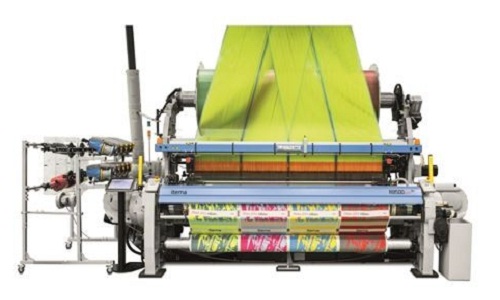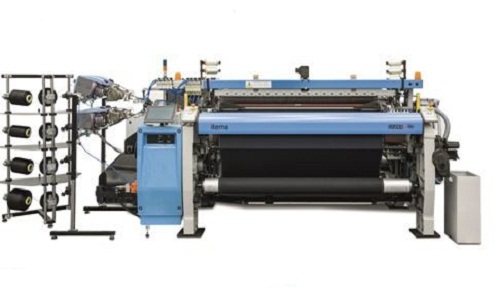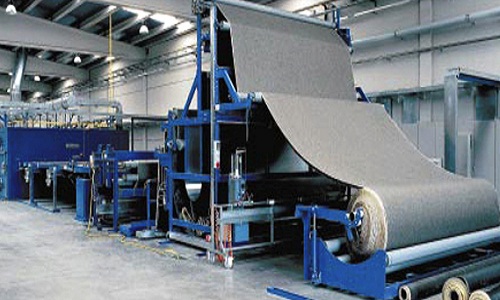FW
Experience the latest technologies and systems from Sedo Treepoint GmbH at INDIA ITME 2016. Governmental initiatives like Industry 4.0 and Make in India will transform the industry dramatically. As tomorrow starts now, textile workshops soon need to adopt. Sedo Treepoint will show its latest smart solutions to start integrated manufacturing already today. The new Sedomat+ line comes with a lot new features. Additionally the new modular SedoIO remote input series makes machine automation more flexible and economical.
Our new production planning simulation tools SedoExpert will optimize production output and takes company organisation to a new level. The integration of continuous and discontinuous machines as well as printing will give unexpected benefits.
To be much more sustainable in the dyeing and finishing with a minimum effort, Sedo Treepoint will present innovative strategies. By using our color management and energy management tools, savings higher 25% e.g. in water could be achieved. For all customers working in Indigo applications, Sedo Treepoint’s new sister company Sedo Engineering will present a revolutionary way to produce ‘Leuco’ indigo on demand.
Italian specialist of fabric finishing machinery, Bianco S.p.A will display the Bianco Happy Scour, an advanced and eco-clean washing line to remove weaving oils with reduced economic and environmental impact at the upcoming ITME India in hall H5, stall A6 B5. With the Bianco Happy Scour, it is now possible to obtain excellent quality fabrics at much lower costs than those incurred in traditional washing.
Bianco Happy Scour has been especially developed for the finishing of knitted or woven fabrics made from synthetic fibre or elastomer, which are the most sensitive to shrinkage and have got the highest oil content. This technology can be successfully applied on all kinds of fabrics, which need to be washed before heat setting.
The shortening of the dyeing time, due to the absence of fabric pre-treatment has minimal damage on fibre; resultantly the fibre properties remain, almost unchanged. The Happy Scour process also guarantees the best recipe in terms of performance and cost saving. The consumption of water inside the washing tank is only given by the fabrics’ absorption. The second rinsing tank gives excellent results, primarily due to the innovative nozzles washing fabrics on both sides, thereby leading to extremely reduced water consumption in the range of 4-6 litres per kg of fabrics.
Indian manufacturer of hot air stenters, InspirOn Engineering Pvt Ltd is showcasing a next generation Stenter, the Motex 15000 at ITME India in hall 5, stall H5C1. When compared with the earlier model Motex 4560, the new model consumes less energy, has better safety features, minimises waste, while offering better operational efficiency and maximum return on investment.
The Motex 15000, while also being manufactured in a sustainable manner, has been developed with unprecedented features and state-of- the-art aesthetics. As against the Motex 4560, the 15000 offers 15% higher drying efficiency and higher operating speed. The Stenter enables the processor to achieve even drying and heat setting at higher evaporation rates with optimum energy utilisation, which translates into lower operating cost per metre of fabric.
The Motex 15000 also achieves consistent and reproducible results across the length and width of the fabric, even with larger overfeed adjustment range up to 80 per cent. It ensures higher stretch, irrespective of the higher GSM of the fabric and is equipped with pin protection flapper for knitted fabrics.
Lindauer Dornier GmbH will present innovative machine concepts for the production of highly sophisticated fabrics at ITME. DORNIER’s ‘Green Machines’ provide the highest weaving quality for technical textiles, sophisticated decorative fabrics and excellent clothing fabrics
The latest machine types of the DORNIER system family comprising rapier and air-jet weaving machines are the centerpoint of the presentation. Experts will demonstrate how Indian weavers can utilize the superior DORNIER technology to master the current weaving mill demands as to the highest quality for fabrics and applications in the individual segments.
Peter D. Dornier, Chairman of the executive board, on the India ITME participation, said, “India is not only a fascinating country, but has become one of our most important markets worldwide concerning weaving and specialty machines. India’s annual economic growth has been above 7 per cent during the last years. Dornier’s share in this development has been quite considerable with about 5,000 new and used rapier and air-jet weaving machines producing precision fabrics in India (besides that more than 35 large Dornier biaxial film stretching lines for thermoplastic films are currently operating in the country – making it the no. 1 polyester packaging film producer in the world).”
Dornier will demonstrate to Indian weavers how they can produce premium quality with high productivity in the rapidly growing market of especially high value and sophisticated clothing fabrics.
ColorJet India Ltd, the biggest Indian manufacturer of digital inkjet printing machines, after massive installations in the Indian market, now looks forward to embark on 100 plus installation of digital textile printing machines by 2017. Incorporated with efficient Indian engineering and spearheaded technology, ColorJet aims to be the leader in digital textile printing technology. In sync with the Make-in-India initiative of Prime Minister Shri Narendra Modi, ColorJet’s ‘Made in India’ technology and state-of–the- art manufacturing facility have been the major breakthroughs in achieving its goals. Through these two initiatives, the company has succeeded in keeping their machine costs, up to 30 per cent lower than Italian and Japanese machines.
“ColorJet digital printers have minimalistic downtimes; since we ensure that multi-point quality checks are done at every stage of manufacturing. Creating customer delight is our top priority and we do not leave any stone unturned in achieving the same,” Smarth Bansal, Brand Manager, Colorjet India said.
At ITME India in Hall 2, Stall A6, ColorJet is showcasing its high speed direct to fabric printer, the Metro, which gives a production speed of up to of 362 sq. metres per hour, and is upgradable upto 16 print heads for achieving the top speed. “With awesome scalable properties, this printer can suit all the needs of the textile printing business and ensures the least payback period and is capable of meeting the ever changing requirements,” Mr Bansal added.
SPGPrints and Stovec Industries Ltd will present the latest SPGPrints digital inkjet and rotary screen printing technologies that enable textile printers to optimise uptime and print on the widest range of fabrics at India-ITME 2016, (booth H5 A16).
Shailesh Wani, MD, Stovec Industries Ltd, said, “We are known for our STORMAC branded RD range of Rotary Printing Machines in India. The latest in the range is RD 8 Individual Drive Machines, which is highly successful. At India ITME 2016, we will be launching the new ‘PEGASUS EVO’ automatic printing machine, a successor to the popular Pegasus EVO from SPGPrints. Stovec will also present the JAVELIN® scanning digital inkjet printer to the Indian market for the first time. The printer will operate throughout the show, giving visitors a real-time experience of its quality, flexibility, productivity and ease of use. Print samples will be available for evaluation. In addition, we will demonstrate our popular screen engraving equipment ‘bestLEN 7412.’”
The Pegasus EVO offers all the functionalities required by ever increasing quality conscious customers. With new features and many options, Pegasus EVO offers quality, reliability and an attractive price-performance ratio that makes it ideal for Indian and international customers. Combined with the possibility of remote diagnostics, the Pegasus EVO is setting new standards in rotary screen printing.
SPGPrints’ JAVELIN scanning digital inkjet printer is designed for companies printing up to two million metres of textiles annually. JAVELIN has proven popular with companies taking the first step into digital textile printing, or with a need to supplement their existing capabilities.
The company Graf, located in Rapperswil near Zurich, is the leading manufacturer of clothings for flat cards, roller cards and combs for combing machines. Graf will introduce several innovative solutions at ITME 2016. Flexible clothings are one of the key components in a carding machine. To ensure an evenly high quality of the carding sliver, they have to be replaced regularly. When the personnel are doing the replacement, the carding machine has to be stopped. To keep these down-times as short as possible, Graf now offers a new flat system, which can reduce the stoppage time by 70 per cent. The so-called EasyTop is used for flat clothings with magnetic adhesion technology. The flats, equipped with a metal carrier, are attached securely and precisely by a high-energy magnet. They resist even high carding forces and guarantee for a high reliability in operation.
Graf presents its new product for the combing process. The exchangeable combing segments are suitable for all combs requiring this technology. The quick and safe installation with the innovative, self-locking fastening system guarantees an absolutely firm seat without wearing out and the constant tightening force on all points of attachment respectively prevents the deformation by prevailing centrifugal forces.

Itema, the world’s largest privately held provider of advanced weaving solutions, including best-in-class weaving machines, spare parts and integrated services, has prepared an impressive product line-up for India ITME 2016 in Mumbai on December 3-8, 2016 (Hall 6, Booth B1). Itema, will leverage this prominent stage to demonstrate its strong commitment to the Indian and neighbouring markets, both in terms of advanced, superior weaving technology and real time, highly qualified after-sales service.
During India ITME, Itema is exhibiting five weaving machines in its booth and one rapier machine with Jacquard application in Stäubli booth. Moreover, the company will highlight the strong advantages of its original spare parts in a dedicated corner, which will be of great interest for many weavers who have installed both the latest Itema machines and the previous Sulzer, Somet and Vamatex models.
Rapier weaving machines

Visitors can get a chance to see live the most successful rapier machine in recent history, the Itema R9500. With a solid installed base in more than 50 countries and the widest range of fabrics produced, the Itema rapier R9500 is nowadays the industry benchmark for versatility and superior textile performances. The R9500 on show during India ITME will display a high-end shirting fabric, featuring the latest technological advancements dedicated specifically to shirting applications, such as the brand-new Itema Pneumatic Tuckers, the most appreciated in this specific market segment allowing reduced maintenance costs and no speed limitations. Moreover, the Itema pneumatic tuckers provide utmost fabric quality and the possibility to have very narrow tucked-in selvedges leading to a significant fabric waste reduction.
Presented for the first time in India, the Itema R9500terry, which is already a big favourite of sophisticated premium terry weavers worldwide after its debut in Milan in 2015, will demonstrate its strong leading position in weaving the most refined and soft terry fabrics.
Airjet weaving machines
In airjet technology, three machines are on display, covering all main airjet technology application fields growing continuously in the Indian and surroundings markets. The A9500 featuring a bed sheeting style, will run with the latest improvements designed to excel in this market, meeting weavers’ requirements of widest versatility and substantial cost savings. The brand-new Full Width Reed Tuckers guarantee weavers the possibility to reduce reed stock and increase the flexibility of the machine. Moreover, the brand-new Double Tandem Nozzles ensure superior fabric quality and significant cost savings.
The third airjet machine is an A9500p weaving top quality yarn-dyed shirting and featuring another Itema patented feature – the ELD Electronic Leno Device – which, with its innovative design, self-cleaning and no need to wind the leno spools, provides a perfect leno binding even at highest speeds, whilst significantly reducing operational costs.

Carlo Rogora, CEO, Itema says, “India ITME 2016 is the perfect stage to show customers our best-in-class weaving machines, fine-tuned and equipped for the occasion with new and innovative technical devices perfect to answer the specific needs of the most requested applications in the Indian and surrounding markets”.
Itema in India
Itema is present in India since 2002, with sales and after-sales teams, technical support and advanced repair centres in Mumbai, Coimbatore, New Delhi and Ichalkaranji to ensure the highest possible standard of weaving solutions, with a complete offering and service to its valuable customers in the Indian market.
Updeep Singh, MD, Itema India avers, “In October, we opened the doors of our new offices in Mumbai and, recently, we established a new electronic repair center in Ichalkaranji, where highly qualified engineers take care of all the electronic components of our weaving machines, ensuring the best assistance to our customers. Itema offers best-in-class rapier, airjet and projectile weaving machines along with a real-time after-sales service, and the key reasons of our weaving machines success in India are the superior textile performance of the machines and the unrivalled expertise of our technicians. Moreover, we are confident in our machines’ reliability and performances that we are the only weaving machine manufacturer to offer two years’ extended warranty.”

India has emerged strong in the global textiles and apparel segment with 5 per cent market share. As of now, India’s market is worth $180 billion and target is to take it up to $300 billion by 2021. To achieve this goal, India needs to strengthen its position across all levels of the value chain. In an exclusive interview Dr. Kavita Gupta, Textile Commissioner, Ministry of Textiles speaks to Fashionating World about the issues confronting the textile industry, and what needs to be done to boost growth in every segment of the overall textiles sector
How do you see India’s textile prowess?
India is the second largest exporter of textiles and apparel next only to China. But we are a distant second. China’s share is almost 40 per cent of global exports; India’s is about five per cent. India can do much more. At one time, we were known for our muslin, yarn and cotton. Our share was as high as 45 per cent of the global market. We have the raw materials, capacity and capability, manpower resources. We are also the fashion hub of textiles. We are coming up well in apparel made-ups. We have a huge spinning capacity.
What’s the way forward?
The domestic market is worth $110 billion. The export market is worth $70 billion. By 2021, we have to increase to $300 billion from $150 billion now. So we have to strengthen each level of the value chain from fiber to fashion. We can reach this target by focusing on value addition. This will increase the value of products. If we sell only at a lower level of the value chain, we don’t get higher realizations. If we focus on value addition, with the same kind of product, we can get bigger and higher value.
If we see our fibre potential, we have approximately 6.5 million tons of cotton fibre and approximately 2.5 million tons of synthetics/man-made fibre/filament yarn. We can increase cotton fibre to a maximum of eight million tons. But we can increase synthetic fibre up to 12 million tons. So that we can reach 20 million tons of fiber strength. This can be done with higher productivity in cotton and by producing more fiber into synthetics. We need policies for fiber neutrality and rationalizing the excise and duty structure. Ideally, in order to increase fiber production, we have to induce investments. This will be both sustainable, and our profit margins will be better, value addition will be better. If we can’t induce investment, we have to rely on fibers coming from outside. In manmade fiber, the excise duty is 12.5% now. Fiber neutrality means all fibers are treated in the same way.
Moreover, we have to balance various segments of the textile value chain. Now we have a strong spinning segment but processing and weaving are relatively weak. We are promoting garments, which we hope will pull up the various segments. Most garments made in the country today, source material from domestic fabrics. If we promote this, the weaving industry gets pulled up. This is one of the aims of the special package for garmenting units.
Are any new schemes in the offing?
India is the biggest cotton producer and exporter. But we have to ensure consistent quality and better delivery mechanism and logistics. This will ensure the exports market has confidence in us. We have to reduce costs and improve pricing. This can only happen with better levels of productivity and efficiency.
Training is necessary for this. Manpower has to be skilled up. We have the Integrated Skill Development Scheme. We give a worker Rs 10,000. We have formulated various modules of training programs and have an independent third party assessment of trainees. This determines if they have acquired the necessary skills. And of the people who have been trained, 70 per cent need to be placed in the entire value chain of the textile sector. For the garment sector, there is a special package for Garments including also a Scheme for Production and Employment Linked Subsidy for Garmenting Unit (SPELSGU). Now, we want to go full steam into both domestic and exports of garments. In both markets, we compete with foreign brands. So, we have to defend the domestic space and capture export markets and also develop our own product brands.
What is the scenario of cotton exports and the development of textiles?
Most of India’s cotton produced is consumed domestically, with small exports. This year because prices are high in the domestic market, exports have automatically come down. But restricting exports will not be beneficial as it will lead to a price rise. In the global competitiveness index, India has jumped 16 notches in a year. That means we are poised for growth. People are now complementing each other. They understand the success of one segment depends on the success of other segments. They are not only concerned about their own segment but want other segments of the value chain to improve or become more competitive. One example is Liva, it’s an example of forward and backward integration. Liva is trying to pull all the segments of the textile value chain. This example should be replicated by other industry partners. I believe people will see the importance of having an integrated approach. We have a greater development of integrated and composite units. A substantial portion of the TUF subsidy has gone into composite units in the textile sector, where different segments of the value chain are integrated.
Does our role in synthetics need to be enhanced?
India’s proportion of cotton to synthetics is 60:40. That means synthetics has a substantial role. So, we are catching up on synthetics. Even in big clusters like Bhiwandi or Surat, it’s mostly synthetics or blends. Cotton blends has the advantage of low maintenance, higher strength, lower cost. So our sectors are moving towards synthetics or blends. Our domestic market is $110 billion and exports is $70 billion. That means, exports are substantial. And India is giving a big push to the garment industry. Garments is the only industry that has a subsidy of 25 per cent. TUF is 15 per cent and there is a 10 per cent additional subsidy. In all other segments, except technical textiles, we have a TUF subsidy of only 10 per cent. We have textile parks that are only garmenting. Made-ups are also coming up in a major way. We have buyer-seller meets, international exhibitions, fashion shows. Branding activity is also taking place. We are looking at developing brands. Many brands are sourcing from India. The garments with brands of Reid and Taylor, Marks & Spencer etc., are made here. But if we can develop five or six brands of our own at the global level in a few years, it will be a huge thing.
Will free trade agreements (FTA) accrue benefits for India?
India is working out FTAs with various countries. But China does not have many FTAs, yet it has penetrated all markets. Indeed, FTAs are important to expand, as they give better access to Indian products in other markets, but FTAs are not the only way to penetrate foreign markets... With TPP, some Indian investors are already going to Vietnam. So we can do what China is doing. We can route our industries and take advantage of TPP by sourcing some part of the value chain over there. We can expect prices in TPP member countries to increase because of demand and supply. There will be pressure for investment in TPP countries. Labor and land costs will over a period rise. Power tariffs too may rise. All this will increase production costs. I have seen many FTAs leading to higher production costs. Because of this, India will become more competitive and we will have a competitive advantage.
How strong are we in economies of scale?
Economies of scale are helpful in bringing down prices and in establishing an integrated value chain. India is looking at policies and programs to encourage economies of scale. Looking at the demand, industry is also moving towards building economies of scale.
What’s the progress in technical textiles?
India is looking at technical textiles. As GDP grows, demand for technical textiles in India will grow. We are promoting the use of technical textiles. India has special technology missions for technical textiles; we have built Centres of Excellence in textile research associations. Apart from R&D, the focus is also on incubation centres in these Centres of Excellence, where people can develop and commercialise new products. The incubation centres have a plug and play model. Without any investment, people can come and develop the product, commercialise it and move out when they are comfortable, so that they make space for a new entrepreneur to develop his product in a commercialised way.
Different Centres of Excellence have been identified for various segments of technical textiles. Geo textiles are used in roads and infrastructure. We have schemes for the use of geo textiles in the Northeast and hilly areas. We are promoting the use of agro textile in agriculture for conserving water and improving crop productivity. We are promoting Meditextiles for hospitals and health care. We also have industrial textiles and protective textiles for industrial and safety purposes.
What about technology upgradation?
Upgrading technology is a crucial area. We either import the technology through TUF or have R&D. We have a special focus on this and are funding research in textiles and textile machinery. This will give a direct impetus to the growth of the textile sector.

Mumbai is hosting the 10th edition India ITME 2016 from December 3 to 8 at NESCO grounds, Goregaon, Mumbai. One of the main highlights of this edition is the ITME-TIT Conference,“Paradigm Shift- What’s Next in Textiles” on December 6. The ITME-TIT Conference is a global conference (with Indian perspective. The conference has been organized by DFU Publications/FashionatingWorld.com and co-organized by TAI Delhi
Power-packed Panelists

The confirmed speakers include top government policy makers, corporate wizards as well as academicians. The chief guest of the ITME-TIT Conference would be Dr Kavita Gupta, Textile Commissioner. The eminent panelists include R D Udeshi, President, Polyester Value Chain, Reliance Industries; Sanjay Jain, President, NITMA & Vice President, FOHMA; VK Ladia, Past Chairman, SRTEPC and MD, Rajashtan Syntex; Rajeev Gopal, Group Executive President, Grasim; and JV Rao, CEO, National Skill Development Council.
The full day conference will see eminent speakers from across the world. The inaugural session ‘India the future is Now’ will focus on India’s position in a globalised world. Dr Kavita Gupta, Textile Commissioner will be the eminent speaker. R D Udeshi, President, Polyester Value Chain, Reliance Industries and Prashant Agarwal, Wazir Advisors will give theme presentation on increasing the Textile & Apparel Trade to $300 bn. There will be several panel discussions on covering topics like: Growth drivers for textile & apparel business for achieving $300 bn; Make in India - Achieving by being competitive in changing global scenario; ITME exclusive on advancement in textile technologies; Future of textiles and future of technical textiles.
ITME will see exhibitors from 92 countries and 1,25,000 visitors and buyers are expected to visit from over 100 countries. ITME has 72 global media and support partners. The event has Who's Who of Indian textile industry across the supply chain specially from yarn, fabrics and raw material side.
The exhibitions gains importance given India is the second largest textile economy in the world after China and is being tipped as the brightest spot in the world of textiles. The industry is aiming to grow from its current size of around $170 billion to $300 billion by 2020. Even now, India accounts for 5 per cent of global textiles and clothing exports after China with a share of 39 per cent.
“India has emerged strong in the global textiles and apparel segment with 5 per cent market share. As of now, India’s market is worth $180 billion and target is to take it up to $300 billion by 2021. To achieve this goal, India needs to strengthen its position across all levels of the value chain,” says Dr Kavita Gupta, Textile Commissioner. “At one time, we were known for muslin, yarn, cotton. So, our share was as high as 45 per cent of the global market. We have the raw materials, capacity and capability, manpower resources. We are also the fashion hub of textiles. We are coming up well in apparel made-ups. We have a huge spinning capacity,” Dr Gupta says.
India’s domestic market is worth $110 billion. The export market is worth $70 billion. “By 2021, we have to increase to $300 billion from $180 dollars now. So, we have to strengthen each level of the value chain from fibre to fashion. We can reach this target by focusing on value addition. This will increase the value of products,” Dr Gupta opines.
FACTS & STATS
India, the second largest textile economy in the world, today accounts for over 5 per cent of global trade in textiles and clothing; is second only to China that has 39 per cent market share. However, the global textiles market moves to the next phase of trade dynamics and readjustments… Can we change the world order in our favour? The conference is going to bring to fore this very question.
The current size of India’s overall textile and clothing industry is $170 -180 billion and to achieve $300 bn, perhaps India needs to target around $100 bn worth of exports with a CAGR of 10 per cent and around $200 bn from domestic market with a CAGR of around 15 per cent in next 5 years. What kind of model should be followed to achieve the targeted $300 bn? Should it be ‘supply driven’ (Push Model) pushing raw material down the stream or should it be ‘demand driven’ (Pull Model), upstream, leading demand to production?
The ITME-TIT Conference will give a perspective to a lot of these issues shaping the dynamics of textile & clothing industry. Exclusive presentations will be made on advancement in Textile Technologies; Future of Spinning, Weaving, Finishing, Technical Textiles (to be conducted by VDMA*) and digital printing.
India ITME, organised every four years, is the second largest event of its kind in the world (after ITMA Europe). The congregation will witness the launch of 24 products over six days besides discussions, knowledge sharing, profiling of artisans, photography exhibition, etc.












